
XL Simpósio Brasileiro de Telecomunicações e Processamento de Sinais
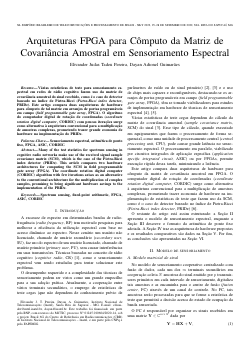
Arquiteturas FPGA para Cômputo da Matriz de Covariância Amostral em Sensoriamento Espectral
Elivander J. T. Pereira, Dayan A. Guimarães
DOI: 10.14209/sbrt.2022.1570810969
Keywords: Sensoriamento espectral aritmética de ponto fixo FPGA CORDIC
Abstract
Many of the test statistics for spectrum sensing in cognitive radio networks make use of the received signal sample covariance matrix (SCM), which is the case of the Pietra-Ricci index detector (PRIDe). This article compares two hardware architectures for computing the SCM in field programmable gate array (FPGA). The coordinate rotation digital computer (CORDIC) algorithm with few iterations arises as an alternative to the conventional architecture for the multiplication of complex samples, promising to bring significant hardware savings to the implementation of the PRIDe.Download

Performance of Cell-Free Massive MIMO Networks under Rayleigh and Rician fading
Thaissa Toyomi Rocha Ueoka, Daynara Dias Souza, Marx Miranda de Freitas, Andre Mendes Cavalcante, Joao Weyl Costa
DOI: 10.14209/sbrt.2022.1570811228
Keywords: Cell-free massive MIMO Channel hardening Favorable propagation Rayleigh and Rician fading
Abstract
This work investigates the impact of different channels fadings on the favorable propagation, channel hardening, and spectral efficiency of the cell-free massive multiple-input multiple-output (MIMO) system. The analyzes consider both line-of-sight (LOS) and non-LOS (NLOS) channels in indoor and outdoor environments. Specifically, the channel may be subject to correlated and uncorrelated Rayleigh or Rician fading. The results indicate that cell-free systems can provide more hardening and spectral efficiency when the channel behaves like a Rician fading. On the other hand, they may benefit from more favorable propagation in Rayleigh fading channels.Download
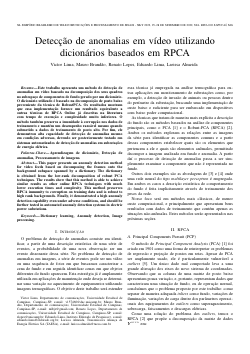
Detecção de anomalias em vídeo utilizando dicionários baseados em RPCA
Victor C Lima, Mauro L Brandão Jr., Renato R Lopes, Eduardo de Lima, Larissa Almeida
DOI: 10.14209/sbrt.2022.1570811637
Keywords: Aprendizagem de dicionário Detecção de anomalias Processamento de imagens
Abstract
Este trabalho apresenta um método de detecção de anomalias em vídeo baseado na decomposição dos seus quadros no subespaço de componentes de fundo gerado por um dicionário. O dicionário utilizado é baseado na decomposição de posto baixo proveniente da técnica de RobustPCA. Os resultados mostram que essa implementação fornece um resultado equivalente a outras técnicas de RPCA Online já descritas na literatura com tempo de execução e complexidade muito inferiores. O método também preserva a imunidade à corrupção nos dados de treinamento e mantém um desempenho razoável mesmo quando submetido a dados de treinamento de posto alto. Por fim, ele demonstrou alta capacidade de detecção de anomalias mesmo em condições adversas, devendo ser posteriormente testado em sistemas automatizados de detecção de anomalias em subestações de energia elétrica.Download
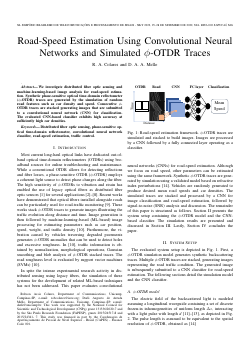
Road-Speed Estimation Using Convolutional Neural Networks and Simulated ϕ-OTDR Traces
Robson Assis Colares, Darli Mello
DOI: 10.14209/sbrt.2022.1570812396
Keywords: Distributed fiber optic sensing Phase-sensitive optical time-domain reflectometer Convolutional neural network classifier Road-speed estimation
Abstract
We investigate distributed fiber optic sensing and machine-learning-based image analysis for road-speed estimation. Synthetic phase-sensitive optical time-domain reflectometer (ϕ-OTDR) traces are generated by the simulation of random road features such as car density and speed. Consecutive ϕ-OTDR traces are stacked generating images that are submitted to a convolutional neural network (CNN) for classification. The evaluated CNN-based classifier exhibits high accuracy at sufficiently high car densities.Download

Semi-blind Two-Stage Estimation of Carrier Frequency Offset for OFDM and OFDMA Systems
Tadeu Ferreira, Sergio Lima Netto, Marcello Campos, Paulo Diniz
DOI: 10.14209/sbrt.2022.1570812415
Keywords: OFDM CFO two-stage estimation
Abstract
Orthogonal Frequency-Division Multiplexing (OFDM) is a technique used in several wireless communication systems. One impairment present in OFDM-based systems is the Carrier Frequency Offset (CFO). The objective of this article is to propose a semi-blind two-stage CFO estimation algorithm for OFDM and for an Orthogonal Frequency-Division Multiple Access system. The proposed algorithm presents lower root-mean squared error metrics in all of the tested scenarios and a reduced complexity than other two-stage algorithms.Download

Algoritmos Empíricos para Estimação da Razão Sinal-Ruído de Barreira no Sensoriamento Espectral via Detecção de Energia
Lucas dos Santos Costa, Dayan A. Guimarães, Bartolomeu F. Uchôa-Filho
DOI: 10.14209/sbrt.2022.1570812510
Keywords: sensoriamento espectral rádios cognitivos detecção de energia razão sinal-ruído de barreira
Abstract
Energy detection (ED) is a widely adopted technique for detecting primary signals in cognitive-radio-based spectrum sensing. However, sensitivity to uncertainties in the knowledge of noise power at receivers is the main drawback that limits the detection capacity of ED and gives rise to the phenomenon called signal-to-noise ratio wall (SNRw). This paper studies the pros and cons of two empirical algorithms for SNRw estimation applicable to ED. Results show that the more recent yields, for example, more precision with lower estimation time. Its predecessor attains lower implementation complexity.Download
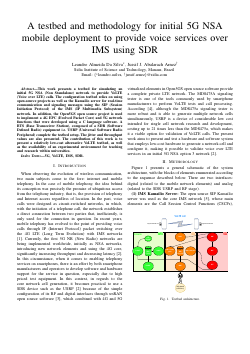
A testbed and methodology for initial 5G NSA mobile deployment to provide voice services over IMS using SDR
Leandro Almeida da Silva, Jussif Junior Abularach Arnez
DOI: 10.14209/sbrt.2022.1570812521
Keywords: 5G VoLTE IMS SDR
Abstract
This research work presents a testbed for simulating an initial 5G NSA (Non Standalone) network to provide VoLTE (Voice over LTE) calls. The configuration testbed relies on using open-source projects as well as the Kamailio server for real-time communication and signaling messages using the SIP (Session Initiation Protocol) protocol of the IMS (IP Multimedia Subsystem) network. In addition, the Open5GS open source project is used to implement a 4G EPC (Evolved Packet Core) and 5G network functions that were develop using a C language software. A BTS (Base Transceiver Station), composed of a SDR (Software Defined Radio) equipment i.e. USRP (Universal Software Radio Peripheral) complete the testbed setup. The jitter and throughput values are also presented. The contribution of this work is to present a relative low cost alternative VoLTE testbed, as well as the availability of an experimental environment for teaching and research within universities.Download
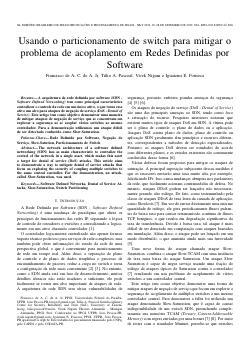
Usando o particionamento de switch para mitigar o problema de acoplamento
Francisco Albuquerque, Túlio Pascoal, Vivek Nigam, Iguatemi E. Fonseca
DOI: 10.14209/sbrt.2022.1570812738
Keywords: SDN Segurança em redes de computadores Ataques de negação de serviço OpenFlow
Abstract
The network architecture of a software defined networking (SDN) has as main characteristic to centralize the control of the network in a single asset, which makes this asset a target for denial of service (DoS) attacks. This article aims to demonstrate a way to mitigate denial of service attacks that focus on exploring the security of coupling multiple switches to the same central controller. For the demonstration, an attack, called Slow-Saturation, was used.Download
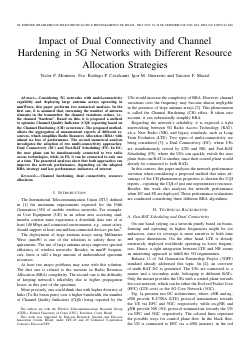
Impact of Dual Connectivity and Channel Hardening in 5G Networks with Different Resource Allocation Strategies
Victor Farias Monteiro, Francisco R. P. Cavalcanti, Igor M. Guerreiro, Tarcisio F. Maciel
DOI: 10.14209/sbrt.2022.1570812747
Keywords: Channel Hardening Dual Connectivity Resource Allocation
Abstract
Considering 5G networks with multi-connectivity capability and deploying large antenna arrays operating in mmWaves, this paper performs two numerical analyses. In the first one, it is assumed that, increasing the number of antenna elements in the transmitter, the channel variations reduce, i.e., the channel "hardens". In the considered scenario, this assumption implies almost no loss of performance, allowing the aggregation of measurement reports of different resources, which simplifies Radio Resource Allocation (RRA). The second numerical analysis investigates the adoption of two multi-connectivity approaches: Dual Connectivity (DC) and Fast-RAT Scheduling (FS). In DC, the user plane can be simultaneously connected to two radio access technologies, while, in FS, it can be connected to only one at a time. The presented analyses show that both approaches can improve the network performance, depending on the adopted RRA strategy and key performance indicators of interest.Download
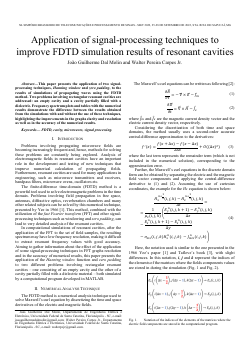
Application of signal-processing techniques to improve FDTD simulation results of resonant cavities
João Guilherme Dal Molin, Walter Pereira Carpes Jr.
DOI: 10.14209/sbrt.2022.1570812751
Keywords: FDTD cavity microwaves signal-processing
Abstract
This paper presents the application of two signal-processing techniques, Hanning window and zero padding, to the results of simulations of propagating waves using the FDTD method. Two problems involving rectangular resonant cavities are addressed: an empty cavity and a cavity partially filled with a dielectric. Frequency spectrum plots and tables with the numerical results demonstrate the difference between the results obtained from the simulations with and without the use of these techniques, highlighting the improvements in the legibility of the graphs and in the accuracy of the numerical results.Download